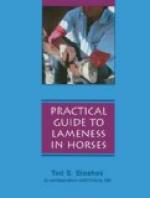Taken as a whole, the tarsal bones, interarticulating and articulating with the tibia and metatarsal bones form the hock joint and this articulation is analagous to the carpus. As with the carpus, there is less movement in the inferior portion of the joint than in the superior part of the articulation. The chief articulating parts are the tibia with the tibial tarsal bone (astragulus).
[Illustration: Fig. 42—Muscles of lower part of thigh, leg and foot; lateral view, o’, Fascia lata; q, q’, q”, biceps femoris; r, semitendinosus; 21’, lateral condyle of tibia. The extensor brevis is visible in the angle between the long and lateral extensor tendons. (After Ellenberger-Baum, Anat. fuer Kuenstler.) (From Sisson’s “Anatomy of the Domestic Animals.")]
The capsular ligament is attached around the margin of the articular surfaces of the tibia, to the tarsal bones, the collateral ligaments (internal and external lateral) and to the metatarsus.
[Illustration: Fig. 43—Right stifle joint; lateral view. The femoro-patellar capsule was filled with plaster-of-Paris and then removed after the cast was set. The femoro-tibial capsule and most of the lateral patellar ligament are removed. M. Lateral meniscus. (From Sisson’s “Anatomy of the Domestic Animals.")]
The common ligaments of the tarsal joint are the collateral, the plantar (calcaneo-metatarsal and c. cuboid) and dorsal ligaments (oblique).
The medial (internal lateral) ligament serves to join the medial (internal) tibial malleolus with tibial tarsal (astragalus) and other tarsal bones.
The lateral (external lateral) ligament is inserted to the lateral (external) tibial malleolus and its distal portions are attached to the tibial tarsal (astragalus), fibular tarsal (calcaneum) bone, fourth tarsal (cuboid) and metatarsus bones.
[Illustration: Fig. 44—Left stifle joint; medial view. The capsules are removed. (From Sisson’s “Anatomy of the Domestic Animals.")]
The plantar ligament (calcaneo-cuboid) is a strong flat band which is attached to the plantar surface of the fibular and fourth tarsal bones (calcaneum and cuboid) and the head of the lateral metatarsal (external small) bone.
The dorsal (oblique) ligament is attached above to the distal tuberosity on the inner side of the tibia. It is inserted below to the central (cuneiform magnum) and third (c. medium) tarsal bones, to the proximal ends of the large and outer small metatarsal bones.
The tarsus is a true hinge joint and because of the great strain which it sustains, is subject to frequent injury. About seventy-five percent of cases of lameness affecting the hind leg may be said to arise from disease of the hock.
As members of locomotion the legs receive strains of two kinds: those of concussion and weight-bearing and strains of propulsion; the latter are the greater. In the horse as a work animal, the hind legs are probably subjected to greater strains than are the front but the manner of construction of the various parts of the pelvic limbs with the possible exception (according to some authorities) of the tibial tarsal joint, offsets this condition.




